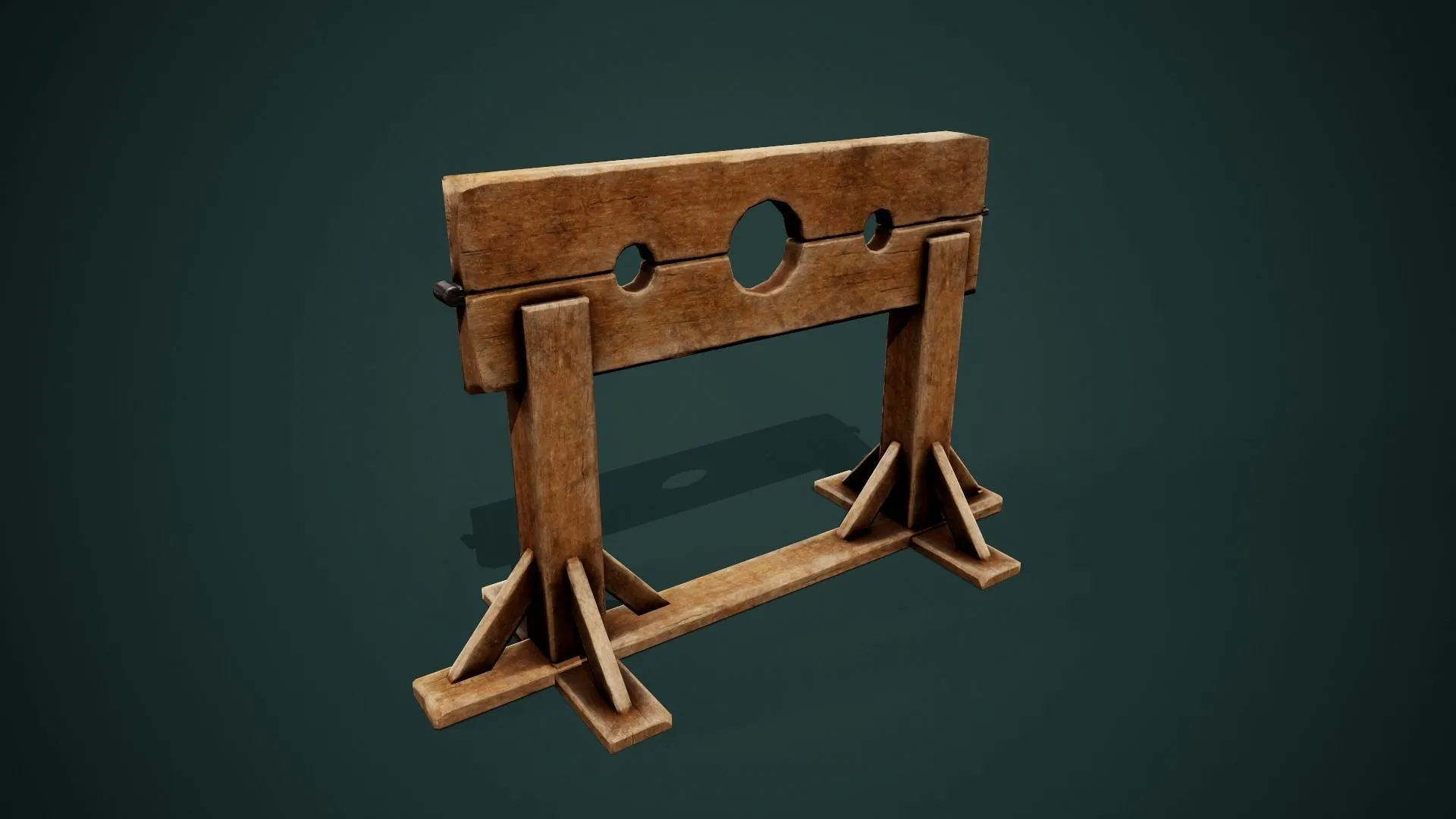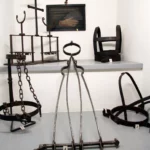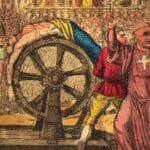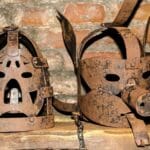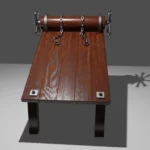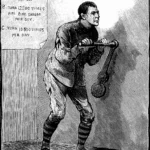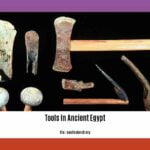Prepare yourself for a chilling journey into the depths of medieval torture. As a skilled historian, I’ll uncover the terrifying tools and methods used to inflict unimaginable pain, exploring the dark motivations that drove their creation. Through painstaking research and eyewitness accounts, I’ll take you on a grim expedition through this macabre chapter of human history, shedding light on the gruesome realities of medieval torture.
Torture Devices of Medieval Times: Inhumane Instruments of Pain
In the harrowing annals of human history, torture has cast an ominous shadow, and medieval times witnessed its most sinister manifestations. These abhorrent devices of torture were employed to extract confessions, instill terror, and administer gruesome punishments.
The Rack: A Tormentous Symphony of Bones
The rack, a devilish frame of wood, was the bane of countless victims. Ropes or chains ensnared their limbs, and with a merciless stretch, the frame elongated their bodies, snapping their bones like brittle twigs.
Impalement Sticks: Agony on a Spine
These sharpened stakes were thrust into the victim’s body through orifices, leaving them writhing in excruciating torment. Left lingering, the sticks ravaged their flesh, leading to a slow and agonizing demise.
Cage for Rat Torture: A Nightmarish Feast
Rats, the companions of filth, were confined within cages and placed upon the victim’s body. Their relentless gnawing inflicted unbearable pain as they feasted on human flesh.
Other Medieval Torture Devices: A Litany of Suffering
Beyond the rack, impalement sticks, and rat torture, a macabre array of other devices filled the dungeons of medieval times:
- The Boot: A metal or wooden contraption that crushed the legs, reducing them to shattered bones.
- Flaying: A gruesome process of skinning victims alive, leaving their bodies exposed and tormented.
- Thumbscrew: A merciless device that squeezed the victim’s thumbs until they burst open.
- Dunking: Submerging the victim’s head underwater for prolonged periods, suffocating them with terror.
- Coffin Torture: Confining victims in claustrophobic boxes for days on end, breaking their spirits and driving them to madness.
These devices were the instruments of a twisted imagination, designed to inflict unimaginable pain and suffering upon their helpless victims. They served as a testament to the darkness that can dwell within the human heart. The use of torture in medieval times remains a haunting reminder of humanity’s capacity for cruelty.
Torture Devices: A Dark History What comes to your mind when you hear the words medieval torture devices? If you’re like most people, you probably think of horrific instruments that were used to inflict unimaginable pain. And you’d be right. Medieval torture devices were some of the most brutal and effective tools of torture ever devised. They were used to punish criminals, extract confessions, and instill fear in the hearts of those who opposed the ruling class. But what were these devices, and how did they work? Torture devices have been used throughout history, but they reached their peak of sophistication during the Middle Ages. This was a time of great social and political upheaval, and torture was often used to maintain order and control. Some of the most common medieval torture devices included the rack, the thumbscrews, and the Iron Maiden. The rack was a simple but effective device that stretched the victim’s body until their bones snapped. The thumbscrews were used to crush the victim’s thumbs, and the Iron Maiden was a spiked chamber that slowly crushed the victim to death.
Impalement Sticks: Medieval Spears of Pain
Imagine the horrifying sight of a towering spear, its sharpened tip piercing through a human body, protruding from the victim’s mouth or neck. This was the gruesome reality of impalement sticks, medieval devices designed to inflict unimaginable pain and humiliation.
Impalement, a barbaric practice, was used in medieval Europe to punish heinous crimes like treason, murder, and heresy. These spears, often crafted from hardwood or metal, were driven into the victim’s body through excruciating orifices like the rectum or vagina, leaving the person’s agonizing body on public display as a macabre warning to others.
The agony caused by impalement was beyond description. Victims would endure days, sometimes even weeks, of excruciating pain as the sharp stake tore through their internal organs and sensitive tissues. Death, when it finally came, was a tortuous and agonizing release.
The Gruesome Mechanics of Impalement
Impalement sticks were not merely pointed spears; they were meticulously designed to inflict maximum suffering. The shafts were often grooved or fluted to create a series of serrated edges, enhancing the device’s ability to tear and puncture the victim’s flesh.
In addition, the tips of the spears were meticulously sharpened, ensuring that they pierced through the body with ease. The length of the spears varied, with some reaching heights of over six feet. This allowed the stakes to be driven through the victim’s body and impaled in the ground, creating a grisly spectacle for all to witness.
Twisted Symbol of Power and Fear
Impalement sticks served not only as instruments of torture but also as twisted symbols of power and fear. The public display of impaled bodies was intended to deter crime and reinforce the authority of the ruling elite. The mere sight of a staked victim was enough to instill terror and obedience in the hearts of the populace.
Historical Usage and Variations
Impalement practices date back to ancient times, but it was during the Middle Ages that they reached their gruesome zenith. The Ottoman Empire, in particular, was infamous for its widespread use of impalement, employing it to quell dissent and punish rebellious subjects.
Variations of impalement sticks also existed, including:
- Skewers: Slender, pointed sticks used to impale the limbs or torso.
- Bayonet Spears: Sharpened military weapons sometimes used for impalement.
- Relays: Multiple shafts connected by chains or ropes, allowing multiple victims to be impaled simultaneously.
A Legacy of Barbarism
The practice of impalement has thankfully been relegated to the annals of history. Today, it serves as a chilling reminder of the brutality and sadism that can prevail in human societies. The pain, suffering, and terror inflicted by impalement sticks forever stain the pages of medieval history as a testament to the dark side of human nature.
Medieval Rat Torture: A Lesson in Fear
In the gruesome realm of medieval torture, rats were not just furry creatures but instruments of excruciating pain and terror.
What Medieval Rat Torture Was Really Like
Torturers would strap victims down and place live rats in a cage over their body. Burning coals were added above the cage, forcing the rats to flee and burrow into the victim’s skin, desperately seeking escape.
The relentless gnawing and tearing caused unimaginable agony. The rats’ sharp teeth ripped at muscles, nerves, and flesh, leaving behind a trail of wounds that could take weeks to heal. This wasn’t just physical torture; it was a psychological assault that broke victims down mentally.
Who Was Tortured?
Rat torture was used for various reasons:
- To force confessions
- To instill fear in the community
- To punish criminals
Anyone could become a target, from suspected witches to political prisoners.
The Execution
- Positioning: Victims were stripped and tied down to a torture apparatus.
- Rat Placement: Live rats were introduced into a cage placed over the victim’s abdomen.
- Fire: Burning coals or embers were added on top of the cage, forcing the rats to burrow into the victim’s body.
- Agony: The rats gnawed and tore at the victim’s flesh, causing excruciating pain and severe wounds.
Torture could last for hours or even days, leaving victims with permanent physical and psychological scars.
The Lasting Impact
Rat torture wasn’t just a cruel punishment; it was a lesson in fear. It instilled a deep-rooted terror in the hearts of those who witnessed it or heard stories of it. It became a symbol of the brutality and cruelty that could be wielded by those in power.
Even centuries later, stories of rat torture continue to horrify and remind us of the darkness that can reside within the human heart.
The Spanish Inquisitions Tools of Terror: Uncovering the Horrors
In the annals of history, the Spanish Inquisition stands as a chilling testament to the depths of religious persecution and unchecked authority. Its arsenal of fearsome torture devices inflicted unimaginable suffering on those who dared to challenge the dominant Catholic doctrine.
Instruments of Agony
The Inquisition’s torturers employed a macabre array of tools designed to crush resistance and extract confessions. Among the most notorious were:
- Strappado: Victims were hoisted upside down with weights tied to their feet, causing excruciating pain and dislocation.
- Water Torture: Water was forced down the throat, creating a sensation of drowning.
- The Rack: Bodies were stretched or twisted, tearing ligaments and breaking joints.
- The Wheel: Bones were shattered and victims were crushed, leading to a slow and agonizing demise.
- Hairshirt: A garment made of coarse animal hair, it caused relentless irritation and discomfort.
Breaking Wills
Torture was not merely a means of punishment; it was a weapon of intimidation. By inflicting unbearable pain, the Inquisition sought to shatter the resolve of its victims, compelling them to renounce their beliefs and embrace Catholicism. The relentless pursuit of religious purity turned the Inquisition into a symbol of fear and oppression.
Enduring Lessons
The horrors perpetrated by the Spanish Inquisition serve as a stark reminder of the dangers of unchecked religious persecution and the fundamental importance of protecting human rights. Its instruments of terror stand as a chilling testament to the fragility of human freedom when intolerance prevails.
Table of Spanish Inquisition Torture Devices:
| Device | Description |
|---|---|
| Strappado | Suspended upside down with weights |
| Water Torture | Drowning sensation created by water forced down the throat |
| The Rack | Body stretched or twisted |
| The Wheel | Bones shattered and victims crushed |
| Hairshirt | Coarse garment causing constant irritation |
Additional Insights:
- The Spanish Inquisition was established in 1478 by King Ferdinand and Queen Isabella.
- It targeted not only heretics but also non-Catholics such as Jews and Muslims.
- The Inquisition’s tactics were condemned by many contemporary observers, including humanists and scholars.
- The Spanish Inquisition was finally abolished in the 19th century.
FAQ
Q1: What were some of the most common torture devices used in medieval times?
A1: The most common torture devices employed in medieval times included instruments such as the rack, impalement sticks, the dunking stool, the pillory, and the iron maiden. These devices were designed to inflict excruciating pain and suffering upon victims, often with the intent of extracting confessions or deterring future crimes.
Q2: Were there any particularly gruesome or unusual torture devices used in the Middle Ages?
A2: Some medieval torture devices, such as flaying, thumb screws, and impaling, were particularly gruesome and brutal. Flaying involved removing the victim’s skin while they were still alive, while thumb screws crushed the victim’s thumbs, inflicting immense pain. Impaling involved inserting sharp objects into the victim’s body, often causing a slow and agonizing death.
Q3: Were torture devices used only to extract confessions or punish criminals?
A3: While torture was primarily used to extract confessions and punish criminals, it was also sometimes employed for purposes of public humiliation and deterrence. Devices like the pillory and the dunking stool were used to subject victims to public ridicule and shame, while other devices, such as the cage for rat torture, were designed to induce intense pain and psychological distress.
Q4: Did all medieval societies use torture as a form of punishment?
A4: The use of torture as a form of punishment was widespread in medieval Europe, but it was not universally practiced across all medieval societies. Some cultures, such as the Islamic world, had a more limited use of torture compared to Europe. Additionally, the extent and severity of torture varied depending on the time period and the specific region within medieval Europe.
Q5: What factors contributed to the widespread use of torture in medieval times?
A5: Several factors contributed to the widespread use of torture in medieval times, including the belief in the guilt of accused individuals, the lack of effective investigative techniques, and the harsh and unforgiving nature of medieval justice systems. Torture was often seen as a necessary means of obtaining confessions and ensuring the conviction of criminals, even in the absence of clear evidence.
- Unraveling Einstein’s Legacy: Who Inherited His Genius? - July 14, 2025
- Unlock Einstein’s Family Tree: Bernhard Caesar & Untold Stories - July 14, 2025
- Unveiling Bernhard Caesar Einstein: His Life & Albert Einstein’s Legacy - July 14, 2025
